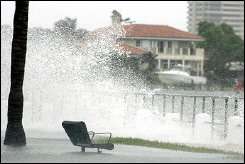October 2, 2005 feature
Oceanic ecosystem in the wake of hurricanes

A federal program to rebuild the ecosystems of the Louisiana Delta at the mouth of the Mississippi River took a hit last month when Hurricane Katrina roared through the gulf. The Golden Meadow Plant Materials Center, which is charged with rebuilding an ever-eroding Louisiana coastline, lost about one-third of its 50,000-to-80,000 plants - which strengthen marshes and island barriers. The plants were located in a greenhouse at the 90-acre facility in Galliano, La., southwest of New Orleans.
Relatively speaking, the plant materials center took a small hit. Coastal Mississippi, however, did not fare so well. Nor did southeastern Louisiana.
"It was a catastrophic event," said Gary Fine, Manager of the United States Agriculture Department's Golden Meadow center, which is one of 26 plant materials centers across the country. Fine and a group of mainly volunteer workers - such as high-school students - may make a trek to the beaches of Mississippi to "try and help them replenish," Fine said.
Before coming to Louisiana, Fine worked in Kansas rebuilding the planes.
"I grew prairie grass in Kansas and I'm growing wetland grass here," Fine said, explaining that the program was initially developed by the government in the 1930s to replant the dust bowl area of the central planes.
It's up to Fine's crew to discover what plants, for instance, can tolerate a great deal of salt. The saltwater from the ocean, combined with rising sea levels, erode and sink the coastline. The stabilization of the Mississippi River's channel - the construction of levees - has cut off sediment-laden overflow that once nourished adjacent wetland areas.
Hurricanes and tropical storms ravage the coast, as well.
By working with plant geneticists, crossing and breeding certain species that can help strengthen the coastline, Fine is using nature's bounty to protect the ecosystems from its wrath by strengthening marshes and island barriers with hardy vegetation.
One of a number of projects Fine is working on involves rebuilding ridges and maritime forests. Using bulldozers to shape the ridgeline, and recreating the maritime forests with plants grown in containers at the facility, the group is able to stabilize the coastal region. Because with each hurricane season, the Gulf of Mexico coastal regions become more vulnerable. Such plants include; 'Vermilion' smooth cord grass; 'Fourchon' bitter panicum; 'Brazoria' seashore paspalum; and 'Fourchon' bitter panicum.
When the coastline recedes, migratory birds from South America can no longer make the trip across the gulf. By rebuilding the maritime forests and coastline, Fine's group is recreating the habitat that sustains the wildlife.
It's one reason Fine likes working in the delicate coastal region.
"It's exciting and rewarding," he said, adding, "It's a fragile environment but it's a dynamic environment."
by Allison Cooper, Copyright 2005 PhysOrg.com

















